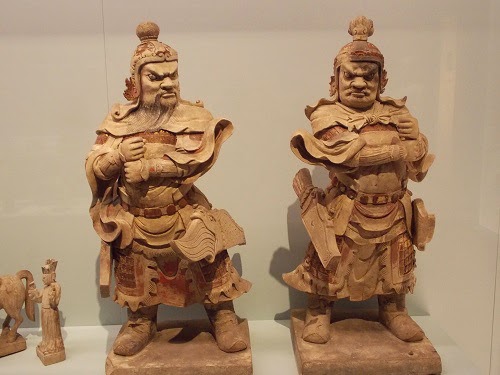 As an end-of-year treat I went to see the 'Ming' exhibition at the British Museum. I've been meaning to see it for a while now but finally found the time, a mere week before it closes. That's cutting it fine. It was nice to see it quite busy but not uncomfortably so.
As an end-of-year treat I went to see the 'Ming' exhibition at the British Museum. I've been meaning to see it for a while now but finally found the time, a mere week before it closes. That's cutting it fine. It was nice to see it quite busy but not uncomfortably so.It's billed as showing objects from 50 years in the Ming dynasty of Chinese emperors, between 1400-1450, the years when the capital moved to Beijing. The Ming dynasty lasted for around 300 years so this exhibition focuses on the artistic flowering of the dynasty at the same time as the early Renaissance was emerging in Italy. There's little to compare the two artistic 'movements' since they have very different roots but they do come together with the final exhibit.
There's a very wide range of objects on display, big and small, some directly impressive and others that you need to look at quite carefully. Some glittery and shiny and others quite plain. But mostly fascinating.
 There were the expected Ming vases and other ceramics but the flowering of art in China at the time was so much more than vases. There was paintings, some with the simple brush strokes evoking cherry blossoms on long scrolls and others were portraits of emperors and senior courtiers. There was metal-work of various kinds, from swords to statues and religious objects. There were cloths and embroideries and lacquerware boxes and all sorts of stuff, something for everyone.
There were the expected Ming vases and other ceramics but the flowering of art in China at the time was so much more than vases. There was paintings, some with the simple brush strokes evoking cherry blossoms on long scrolls and others were portraits of emperors and senior courtiers. There was metal-work of various kinds, from swords to statues and religious objects. There were cloths and embroideries and lacquerware boxes and all sorts of stuff, something for everyone. One of my favourite exhibits was a pair of generals guarding a tomb, with the detail in their clothes and boots and helmets, their grim facial expressions that say 'don't mess with me or else' that made me smile (for which I apologised since they're supposed to invoke terror). They're both about three feet tall and would've held a spear (see their hands linked around something no longer there). The detail of their clothes is astonishing and even the stitching of their boots can still plainly be seen. I'd love to have them guarding my front door, one on each side - they would keep the junk mail away most satisfactorily, I think.
One of my favourite exhibits was a pair of generals guarding a tomb, with the detail in their clothes and boots and helmets, their grim facial expressions that say 'don't mess with me or else' that made me smile (for which I apologised since they're supposed to invoke terror). They're both about three feet tall and would've held a spear (see their hands linked around something no longer there). The detail of their clothes is astonishing and even the stitching of their boots can still plainly be seen. I'd love to have them guarding my front door, one on each side - they would keep the junk mail away most satisfactorily, I think.One part of the exhibition was about religion at the time and held various religious artefacts from the time. One display case held examples t represent the main religions practiced at the time: a lovely bronze Buddha image, a Daoist tableaux showing a hierarchy of the gods and a small copy of the Koran with Chinese symbols. I had no idea that Islam was so widespread in China at the time but, given that China traded with a good portion of the world it's not really that surprising.
The final exhibit is an Italian painting - 'The Adoration of the Magi' by Mantegna - that stood out like a sore thumb in the exhibition. It was there to show the extent of Chinese influence. Look closely ad you'll see the bald Magi presenting a small white and blue porcelain bowl filled with gold for the Christ child. In a display case beside the painting was a small porcelain bowl with a similar floral design. The bowl in the painting has been identified as having been made in the imperial factory in Jingdezhen sometime between 1403-1424. When Mantegna was working in Italy at the end of the 1400s the Ming porcelain was a treasure of such value and rarity that it was appropriate to show it as fitting gift for the son of God.
It's a fascinating exhibition but it closes on 5 January 2015 - go and see it if you can.


No comments:
Post a Comment